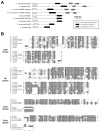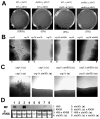Ste50 adaptor protein governs sexual differentiation of Cryptococcus neoformans via the pheromone-response MAPK signaling pathway
- PMID: 20971202
- PMCID: PMC3006040
- DOI: 10.1016/j.fgb.2010.10.006
Ste50 adaptor protein governs sexual differentiation of Cryptococcus neoformans via the pheromone-response MAPK signaling pathway
Abstract
The mitogen-activated protein kinase (MAPK) pathways control diverse cellular functions in pathogenic fungi, including sexual differentiation, stress response, and maintenance of cell wall integrity. Here we characterized a Cryptococcus neoformans gene, which is homologous to the yeast Ste50 that is known to play an important role in mating pheromone response and stress response as an adaptor protein to the Ste11 MAPK kinase kinase in Saccharomyces cerevisiae. The C. neoformans Ste50 was not involved in any of the stress responses or virulence factor production (capsule and melanin) that are controlled by the HOG and Ras/cAMP signaling pathways. However, Ste50 was required for mating in both serotype A and serotype D C. neoformans strains. The ste50Δ mutant was completely defective in cell-cell fusion and mating pheromone production. Double mutation of the STE50 gene blocked increased production of pheromone and the hyper-filamentation phenotype of cells deleted of the CRG1 gene, which encodes the RGS protein that negatively regulates pheromone responsive G-protein signaling via the MAPK pathway. Regardless of the presence of the basidiomycota-specific SH3 domains of Ste50 that are known to be required for full virulence of Ustilago maydis, Ste50 was dispensable for virulence of C. neoformans in a murine model of cryptococcosis. In conclusion, the Ste50 adaptor protein controls sexual differentiation of C. neoformans via the pheromone-responsive MAPK pathway but is not required for virulence.
Copyright © 2010 Elsevier Inc. All rights reserved.
Figures







Similar articles
-
Role of the Heme Activator Protein Complex in the Sexual Development of Cryptococcus neoformans.mSphere. 2022 Jun 29;7(3):e0017022. doi: 10.1128/msphere.00170-22. Epub 2022 May 31. mSphere. 2022. PMID: 35638350 Free PMC article.
-
Insertional mutagenesis combined with an inducible filamentation phenotype reveals a conserved STE50 homologue in Cryptococcus neoformans that is required for monokaryotic fruiting and sexual reproduction.Mol Microbiol. 2011 Feb;79(4):990-1007. doi: 10.1111/j.1365-2958.2010.07501.x. Mol Microbiol. 2011. PMID: 21299652
-
Signal transduction cascades regulating mating, filamentation, and virulence in Cryptococcus neoformans.Curr Opin Microbiol. 1999 Aug;2(4):358-62. doi: 10.1016/S1369-5274(99)80063-0. Curr Opin Microbiol. 1999. PMID: 10458985 Review.
-
Mutation of the regulator of G protein signaling Crg1 increases virulence in Cryptococcus neoformans.Eukaryot Cell. 2004 Aug;3(4):1028-35. doi: 10.1128/EC.3.4.1028-1035.2004. Eukaryot Cell. 2004. PMID: 15302835 Free PMC article.
-
The role of adaptor protein Ste50-dependent regulation of the MAPKKK Ste11 in multiple signalling pathways of yeast.Curr Genet. 2003 Jun;43(3):161-70. doi: 10.1007/s00294-003-0383-6. Epub 2003 Mar 11. Curr Genet. 2003. PMID: 12764668 Review.
Cited by
-
Unique roles of the unfolded protein response pathway in fungal development and differentiation.Sci Rep. 2016 Sep 15;6:33413. doi: 10.1038/srep33413. Sci Rep. 2016. PMID: 27629591 Free PMC article.
-
Role of the Heme Activator Protein Complex in the Sexual Development of Cryptococcus neoformans.mSphere. 2022 Jun 29;7(3):e0017022. doi: 10.1128/msphere.00170-22. Epub 2022 May 31. mSphere. 2022. PMID: 35638350 Free PMC article.
-
Comparative transcriptomic analysis for identification of candidate sex-related genes and pathways in Crimson seabream (Parargyrops edita).Sci Rep. 2021 Jan 13;11(1):1077. doi: 10.1038/s41598-020-80282-5. Sci Rep. 2021. PMID: 33441831 Free PMC article.
-
Comparative transcriptome sequencing analysis of female and male Decapterus macrosoma.PeerJ. 2022 Nov 8;10:e14342. doi: 10.7717/peerj.14342. eCollection 2022. PeerJ. 2022. PMID: 36389430 Free PMC article.
-
Distinct and redundant roles of protein tyrosine phosphatases Ptp1 and Ptp2 in governing the differentiation and pathogenicity of Cryptococcus neoformans.Eukaryot Cell. 2014 Jun;13(6):796-812. doi: 10.1128/EC.00069-14. Epub 2014 Apr 11. Eukaryot Cell. 2014. PMID: 24728196 Free PMC article.
References
-
- Alspaugh JA, et al. RAS1 regulates filamentation, mating and growth at high temperature of Cryptococcus neoformans. Mol Microbiol. 2000;36:352–65. - PubMed
-
- Alspaugh JA, et al. Signal transduction pathways regulating differentiation and pathogenicity of Cryptococcus neoformans. Fungal Genet Biol. 1998;25:1–14. - PubMed
-
- Bahn YS, et al. Carbonic anhydrase and CO2 sensing during Cryptococcus neoformans growth, differentiation, and virulence. Curr Biol. 2005a;15:2013–20. - PubMed
Publication types
MeSH terms
Substances
Associated data
- Actions
- Actions
Grants and funding
LinkOut - more resources
Full Text Sources
Other Literature Sources
Molecular Biology Databases

